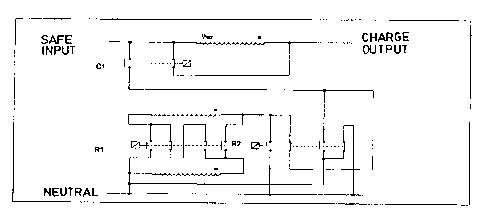Une partie des informations de ce site Web a été fournie par des sources externes. Le gouvernement du Canada n'assume aucune responsabilité concernant la précision, l'actualité ou la fiabilité des informations fournies par les sources externes. Les utilisateurs qui désirent employer cette information devraient consulter directement la source des informations. Le contenu fourni par les sources externes n'est pas assujetti aux exigences sur les langues officielles, la protection des renseignements personnels et l'accessibilité.
L'apparition de différences dans le texte et l'image des Revendications et de l'Abrégé dépend du moment auquel le document est publié. Les textes des Revendications et de l'Abrégé sont affichés :
| (12) Demande de brevet: | (11) CA 2372848 |
|---|---|
| (54) Titre français: | STABILISATEUR DE TENSION POUR APPLICATIONS DE TRANSPORT ET DE DISTRIBUTION D'ENERGIE ELECTRIQUE |
| (54) Titre anglais: | VOLTAGE STABILIZER FOR ELECTRICAL ENERGY TRANSPORTATION AND DISTRIBUTION APPLICATIONS |
| Statut: | Réputée abandonnée et au-delà du délai pour le rétablissement - en attente de la réponse à l’avis de communication rejetée |
| (51) Classification internationale des brevets (CIB): |
|
|---|---|
| (72) Inventeurs : |
|
| (73) Titulaires : |
|
| (71) Demandeurs : |
|
| (74) Agent: | ROBIC AGENCE PI S.E.C./ROBIC IP AGENCY LP |
| (74) Co-agent: | |
| (45) Délivré: | |
| (22) Date de dépôt: | 2002-02-21 |
| (41) Mise à la disponibilité du public: | 2002-08-23 |
| Licence disponible: | S.O. |
| Cédé au domaine public: | S.O. |
| (25) Langue des documents déposés: | Anglais |
| Traité de coopération en matière de brevets (PCT): | Non |
|---|
| (30) Données de priorité de la demande: | ||||||
|---|---|---|---|---|---|---|
|
Voltage stabiliser for electrical energy
transportation and distribution applications, which
consists of one or several electromagnetic devices of
transformer type which, at discrete intervals,
regulates the output voltage that reaches the consumer,
taking the form of a transformer with a dual or
quadruple primary winding and a simple secondary
winding, the simple winding being able to be positioned
before or after the parallel branch, the performance of
the equipment remaining the same.
Note : Les revendications sont présentées dans la langue officielle dans laquelle elles ont été soumises.
Note : Les descriptions sont présentées dans la langue officielle dans laquelle elles ont été soumises.

2024-08-01 : Dans le cadre de la transition vers les Brevets de nouvelle génération (BNG), la base de données sur les brevets canadiens (BDBC) contient désormais un Historique d'événement plus détaillé, qui reproduit le Journal des événements de notre nouvelle solution interne.
Veuillez noter que les événements débutant par « Inactive : » se réfèrent à des événements qui ne sont plus utilisés dans notre nouvelle solution interne.
Pour une meilleure compréhension de l'état de la demande ou brevet qui figure sur cette page, la rubrique Mise en garde , et les descriptions de Brevet , Historique d'événement , Taxes périodiques et Historique des paiements devraient être consultées.
| Description | Date |
|---|---|
| Demande non rétablie avant l'échéance | 2008-02-21 |
| Le délai pour l'annulation est expiré | 2008-02-21 |
| Inactive : Abandon.-RE+surtaxe impayées-Corr envoyée | 2007-02-21 |
| Réputée abandonnée - omission de répondre à un avis sur les taxes pour le maintien en état | 2007-02-21 |
| Demande publiée (accessible au public) | 2002-08-23 |
| Inactive : Page couverture publiée | 2002-08-22 |
| Modification reçue - modification volontaire | 2002-08-15 |
| Lettre envoyée | 2002-07-15 |
| Inactive : Transfert individuel | 2002-05-17 |
| Inactive : CIB en 1re position | 2002-04-26 |
| Inactive : CIB attribuée | 2002-04-26 |
| Inactive : Lettre de courtoisie - Preuve | 2002-03-26 |
| Inactive : Certificat de dépôt - Sans RE (Anglais) | 2002-03-21 |
| Demande reçue - nationale ordinaire | 2002-03-20 |
| Date d'abandonnement | Raison | Date de rétablissement |
|---|---|---|
| 2007-02-21 |
Le dernier paiement a été reçu le 2006-02-03
Avis : Si le paiement en totalité n'a pas été reçu au plus tard à la date indiquée, une taxe supplémentaire peut être imposée, soit une des taxes suivantes :
Les taxes sur les brevets sont ajustées au 1er janvier de chaque année. Les montants ci-dessus sont les montants actuels s'ils sont reçus au plus tard le 31 décembre de l'année en cours.
Veuillez vous référer à la page web des
taxes sur les brevets
de l'OPIC pour voir tous les montants actuels des taxes.
| Type de taxes | Anniversaire | Échéance | Date payée |
|---|---|---|---|
| Taxe pour le dépôt - petite | 2002-02-21 | ||
| Enregistrement d'un document | 2002-05-17 | ||
| TM (demande, 2e anniv.) - petite | 02 | 2004-02-23 | 2004-02-05 |
| TM (demande, 3e anniv.) - petite | 03 | 2005-02-21 | 2005-02-03 |
| TM (demande, 4e anniv.) - petite | 04 | 2006-02-21 | 2006-02-03 |
Les titulaires actuels et antérieures au dossier sont affichés en ordre alphabétique.
| Titulaires actuels au dossier |
|---|
| UNIVERSIDAD PONTIFICIA COMILLAS |
| Titulaires antérieures au dossier |
|---|
| DAVID SOLER SONEIRA |
| RAFAEL CHAO GOMEZ |